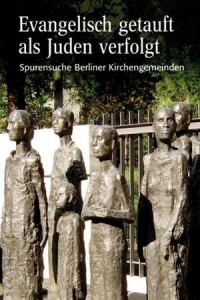Contemporary Church History Quarterly
Volume 18, Number 4 (December 2012)
Review of Hildegard Frisius, Marianne Kälberer, Wolfgang G. Krogel, Gerlind Lachenicht, Frauke Lemmel, eds., Evangelisch getauft – als Juden verfolgt. Spurensuche Berliner Kirchengemeinden (Berlin: Wichern–Verlag, 2008), 452 Pp.
By Manfred Gailus, Technische Universität Berlin
On November 20th 2002, a day of Prayer and Repentance, Bishop Wolfgang Huber, who was the Chairman of the Council of the Evangelische Kirche in Deutschland (EKD) from 2003 to 2009, held a remarkably self-critical sermon in St. Paul’s Church, Berlin-Zehlendorf, commemorating the fate of the non-aryan Christians during Third Reich. Rarely if ever had a leading representative of Germany’s Protestant churches spoken out so clearly about what happened to the Christians of Jewish origin, or confessed the guilt of the churches and their fellow Christians. After this sermon, various groups in some 16 Berlin parishes started investigations to discover the identities of these former “baptized Jews”, and formed a “working group” to discuss research problems and present their findings. Altogether, after a long-lasting and pain-staking research process, they identified some 300 former “non-aryan Christians” from their own Berlin parishes i.e. persons, who had been deported to the East during the Second World War. Only eight of them survived.
 This book describes how this research was undertaken, for instance the hard work of looking through thousands of pages of dusty old “Taufbücher” (baptism registers), and the results of this laudable research initiative from below. It is not an academic or scientific book in the strict sense. However, the initiative in itself and many of the results are more than respectable. Some of the researchers were able to reconstruct biographies about “non-aryan Christians” at full length – biographies that were often completely unknown and forgotten up to the present day. In some parishes, the identification of their deported former fellow Christians was the first step to the installation of commemorative plaques in the entrance halls of churches, or for the installation of the so called “Stolpersteine” (small metallic plaques in the pavement with biographical data) in front of their houses. In a lengthy article, Wolfgang G. Krogel repeats the earlier findings about the “Sippenforschungen” of the Berlin Nazi parson Karl Themel (“Kirchenbuchstelle Alt-Berlin – ein Hilfsorgan des NS-Staates”, pp. 297-361). The book also contains a list of 35 deported women and 53 deported men belonging to Protestant parishes in Berlin, as derived from the “Fremdstämmigen-Kartei” (Aliens’ Card-Index) produced by Themel in his “Kirchenbuchstelle Alt-Berlin” (pp. 366-373). In it, the information under the rubric “date and place of deportation” reads like this: Theresienstadt, Riga, Minsk, suicide Berlin, Auschwitz, Treblinka. Finally, the book reprints three outstanding documents: parts of the famous and courageous sermon by Helmut Gollwitzer, given on the day of Prayer and Repentance on November 16th 1938 in Berlin-Dahlem; the sermon of Johannes Hildebrandt in commemoration of the November 1938 pogrom, given at the Sophiengemeinde (then in East Berlin) in 1978; and, as already mentioned, the 2002 sermon by Wolfgang Huber in Berlin-Zehlendorf.
This book describes how this research was undertaken, for instance the hard work of looking through thousands of pages of dusty old “Taufbücher” (baptism registers), and the results of this laudable research initiative from below. It is not an academic or scientific book in the strict sense. However, the initiative in itself and many of the results are more than respectable. Some of the researchers were able to reconstruct biographies about “non-aryan Christians” at full length – biographies that were often completely unknown and forgotten up to the present day. In some parishes, the identification of their deported former fellow Christians was the first step to the installation of commemorative plaques in the entrance halls of churches, or for the installation of the so called “Stolpersteine” (small metallic plaques in the pavement with biographical data) in front of their houses. In a lengthy article, Wolfgang G. Krogel repeats the earlier findings about the “Sippenforschungen” of the Berlin Nazi parson Karl Themel (“Kirchenbuchstelle Alt-Berlin – ein Hilfsorgan des NS-Staates”, pp. 297-361). The book also contains a list of 35 deported women and 53 deported men belonging to Protestant parishes in Berlin, as derived from the “Fremdstämmigen-Kartei” (Aliens’ Card-Index) produced by Themel in his “Kirchenbuchstelle Alt-Berlin” (pp. 366-373). In it, the information under the rubric “date and place of deportation” reads like this: Theresienstadt, Riga, Minsk, suicide Berlin, Auschwitz, Treblinka. Finally, the book reprints three outstanding documents: parts of the famous and courageous sermon by Helmut Gollwitzer, given on the day of Prayer and Repentance on November 16th 1938 in Berlin-Dahlem; the sermon of Johannes Hildebrandt in commemoration of the November 1938 pogrom, given at the Sophiengemeinde (then in East Berlin) in 1978; and, as already mentioned, the 2002 sermon by Wolfgang Huber in Berlin-Zehlendorf.
To sum up, this is a remarkable book, which grew out of an initiative of engaged Berlin Protestants who are more or less hobby or half-professional historians, in order to give remembrance to their former non-aryan fellow Christians. However, the book is not yet the professional scholarly study on this issue that is so badly needed for the whole Berlin area. One has to remember the fact that Berlin housed not only the largest Jewish community in Germany during the 1930s, but was also the home of some 20-30 000 baptized Jews belonging to the Protestant churches, which to a large extent were governed at that time by the strongly antisemitic German Christians who betrayed and expelled their non-aryan fellow Christians. So, much more remains to be done, to bring to the present day and age this awful story so full of guilt and shame.
